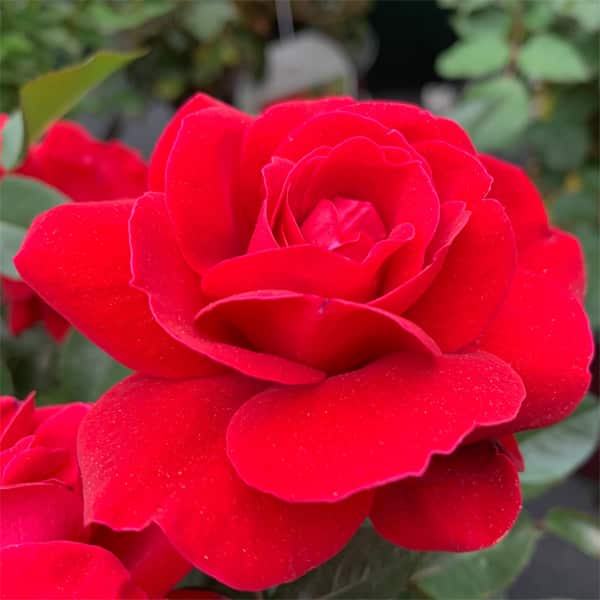
By Kathy Bergmann, Weston Nurseries Staff
I’ve lived for the last thirty-four years in a farmhouse built in 1730. If you’re thinking huge copper beeches or a sugar maple for the record books, think again. Apart from some majestic shagbark hickories on the edges of the property and a magnificent Norway spruce by the foundation of a long-gone outbuilding, there was no landscaping but the wrong landscaping when we moved in. So- when I wasn’t raising three kids or running a gift shop out of our barn, I’ve spent a few decades creating a landscape that – I hope- reflects the history and the beauty of the house and the land.
And this, of course, creates a problem. For example, a lovely little variegated Japanese maple that had me swooning at work would look anachronistic in front of a farmhouse built when JS Bach was in his glory and Beethoven wouldn’t even be born for forty years. Likewise a dwarf Alberta spruce, Hinoki cypress, or anything pruned to look like a theme-park animal.
That doesn’t mean that you can’t find a spot somewhere else on your property for any of the above, (that Japanese maple is mine, all mine!) if you really like them. But the owners of ancient houses often consider ourselves caretakers of history, and many of us try to plant accordingly around these buildings, within reason.
Some historians believe, for example, that nothing should ever be planted to obscure the foundation of a house built up to and including the Federal Period since, for the most part, people didn’t do that back then. I can’t say that I’m quite that militaristic, but I do understand the concept. Nevertheless, witness my Clethra, winterberry, Cornus mas and sambucus, but just disregard the hosta. Nobody’s perfect.
Now we get into the difference between renovation and restoration. A person who renovates an old house enjoys central heat and flush toilets along with his eight fireplaces and wide pine floors. A person who restores a house is living in Sturbridge Village. Likewise, in the garden we should allow ourselves a certain willing suspension of disbelief.
A major example: lilacs have bloomed by kitchen doors for so many centuries here in New England that a lilac found growing in woods or empty fields means that a cellar hole often may be found close by. Native shrub, right? Nope. Brought here by European settlers hundreds of years ago, and they found them in Asia. That’s why lilacs prefer a shot of lime when living in our acid eastern Massachusetts soil, but that’s a story for another day. Let’s just say that, because of its long history with us, we’re willing to let the lilac share space with our winterberry and witch hazel.
Another example of our European- with help from Asian- roots is the holly, not the native Ilex opaca that I use whenever I can find it and have the proper space for its ultimate size and shape, but the meserve that is the closest you can easily get to anything European. It’s interesting to note that the Druids, who were very much still around in what is now Great Britain and Germany less than a thousand years ago, and who brought us Halloween, Mid-summer’s eve and the Winter solstice, believed that planting holly by your door would bring you the ultimate in good luck. I use my hollies to make the wreaths I put up on my doors, hoping that I don’t upset the original owners with such Pagan rituals.
I also like to utilize the natural evolution of my own native shrubs and trees. Let them grow where they will, but prune and thin judiciously and be careful not to allow any invasives in to play. The result is my path to nowhere. You’d never believe that at the bottom of that little slope is McMansion city. Ugh. At least they get the deer and I don’t.
Sometimes, however, even the most stalwart of caretakers gives in to sentiment. Once I was in love with the sweetest, silliest little black and white tuxedo cat nicknamed Little Guy. At night he would lie down beside me, wrap his paws around my wrist, rest his cheek on the back of my hand and fall asleep purring. In the warm months he was fascinated by moths and butterflies. He’d raise his paws above his head and jump straight up, levitating to try to catch one. I can’t remember his actually succeeding, but he certainly enjoyed the hunt.
Little Guy died six winters ago. It was a particularly mild February, so we were able to wrap him in his favorite blanket and bury him in the perennial garden outside the kitchen without any trouble. In late April, I planted a butterfly bush near his head. I knew how much he would love watching all those butterflies come and go through the summer.
Now, I know Buddleia isn’t native. I know it came from China only a little over a century ago. I saw it in native plantings along with lilac while climbing down the Great Wall last year. But I also know that if the first owner of my house, Ebenezer Hill, were suddenly to materialize on my front steps to demand an explanation for the purple-flowered interloper that can now be seen clearly from what had been his bedroom window, I would politely ask him to leave.
The only thing that matters to me is that my Little Guy has finally caught himself a butterfly.









